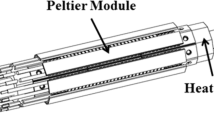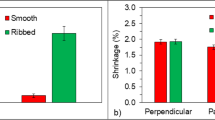Abstract
Rapid heating cycle molding (RHCM) is a novel plastic injection molding process. It can be used effectively to prevent many defects of products produced in conventional injection molding process. In this paper, the panel of large-size liquid crystal display TV was taken as an example. Thermal, deformation, and fatigue analysis models for RHCM injection mold were established. Firstly, by analyzing the heat transfer process of the RHCM mold, the temperature distributions on the mold cavity surface were studied. Secondly, through numerical simulation, the tendency of the stress and deformation of the RHCM mold was obtained. It showed that the fixing mode between the stationary mold insert and the stationary mold plate had a great influence on the thermal stress and deformation of the mold. As a result, a new fixing mode for the stationary mold insert was proposed which could effectively decrease the deformation caused by the temperature changing. Lastly, the lifetime of the mold under different fixing modes was evaluated, and reasonable suggestions which could improve the lifetime of RHCM mold were also proposed. Application in engineering proved that it was a very effective way to improve the lifetime of RHCM mold by using the suggested fixing mode.
Similar content being viewed by others
References
Chen Y F, Yang V, Yang W H, Chang R Y (2006) True 3D and fully transient mold temperature simulation for RHCM process. SPEATC 3
Chen SC, Jong WR, Chang JA (2006) Dynamic mold surface temperature control using induction heating and its effects on the surface appearance of weld line. J Appl Polym Sci 101:1174–1180. doi:10.1002/app. 24070
Au KM, Yu KM (2007) A scaffolding architecture for conformal cooling design in rapid plastic injection moulding. Int J Adv Manuf Technol 34:496–515. doi:10.1007/s00170-006-0628-x
Nakao M, Tsuchiya K, Sadamitsu T, Ichikohara Y, Ohba T, Ooi T (2008) Heat transfer in injection molding for reproduction of sub-micron-sized features. Int J Adv Manuf Technol 38(3–4):426–432. doi:10.1007/s00170-007-1343-y
Dimla DE, Camilotto M, Miani F (2005) Design and optimisation of conformal cooling channels in injection moulding tools. J Mater Process Technol 164–165:1294–1300. doi:10.1016/j.jmatprotec.2005.02.162
Tang SH, Kong YM, Sapuan SM, Samin R, Sulaiman S (2006) Design and thermal analysis of plastic injection mould. J Mater Process Technol 171(2):259–267. doi:10.1016/j.jmatprotec.2005.06.075
Shiraishi Y, Norikane H, Narazaki N, Kikutani T (2002) Analysis of heat flux from molten polymers to molds in injection molding processes. Int Polym Process 17:166–175
Kim CH, Youn JR (2007) Determination of residual stresses in injection-moulded flat plate: simulation and experiments. Polym Test 26(7):862–868. doi:10.1016/j.polymertesting.2007.05.006
Gao YH, Wang XC (2008) An effective warpage optimization method in injection molding based on the Kriging model. Int J Adv Manuf Technol 37:953–960. doi:10.1007/s00170-007-1044-6
Zhang HL, Ong NS, Lam YC (2008) Mold surface roughness effects on cavity filling of polymer melt in micro injection molding. Int J Adv Manuf Technol 37:1105–1112. doi:10.1007/s00170-007-1060-6
Erzurumlu T, Ozcelik B (2006) Minimization of warpage and sink index in injection-molded thermoplastic parts using Taguchi optimization method. Mater Des 27(10):853–861
Aisa J, Javierre C, Serna JA (2006) An example of simulation tools use for large injection moulds design. J Mater Process Tech 175(1–3):15–19
Chen SC, Peng HS, Chang JA, Jong WR (2004) Simulation and verification of induction heating on a mold plate. Int J Heat Mass Transfer 31(7):971–980
Chang PC, Hwang S (2006) Simulation of infrared rapid surface heating for injection molding. Int J Heat Mass Transfer 49:3846–3854
Kang MH (2007) Wonder injection molding with momentary mold surface heating process. CAE Molding Conference in Taiwan, Republic of China
Wang RJ, Shang DG (2009) Low-cycle fatigue life prediction of spot welds based on hardness distribution and finite element analysis. Int J Fatig 31:508–514
Author information
Authors and Affiliations
Corresponding author
Rights and permissions
About this article
Cite this article
Li, X., Zhao, G., Guan, Y. et al. Research on thermal stress, deformation, and fatigue lifetime of the rapid heating cycle injection mold. Int J Adv Manuf Technol 45, 261–275 (2009). https://doi.org/10.1007/s00170-009-1969-z
Received:
Accepted:
Published:
Issue Date:
DOI: https://doi.org/10.1007/s00170-009-1969-z




